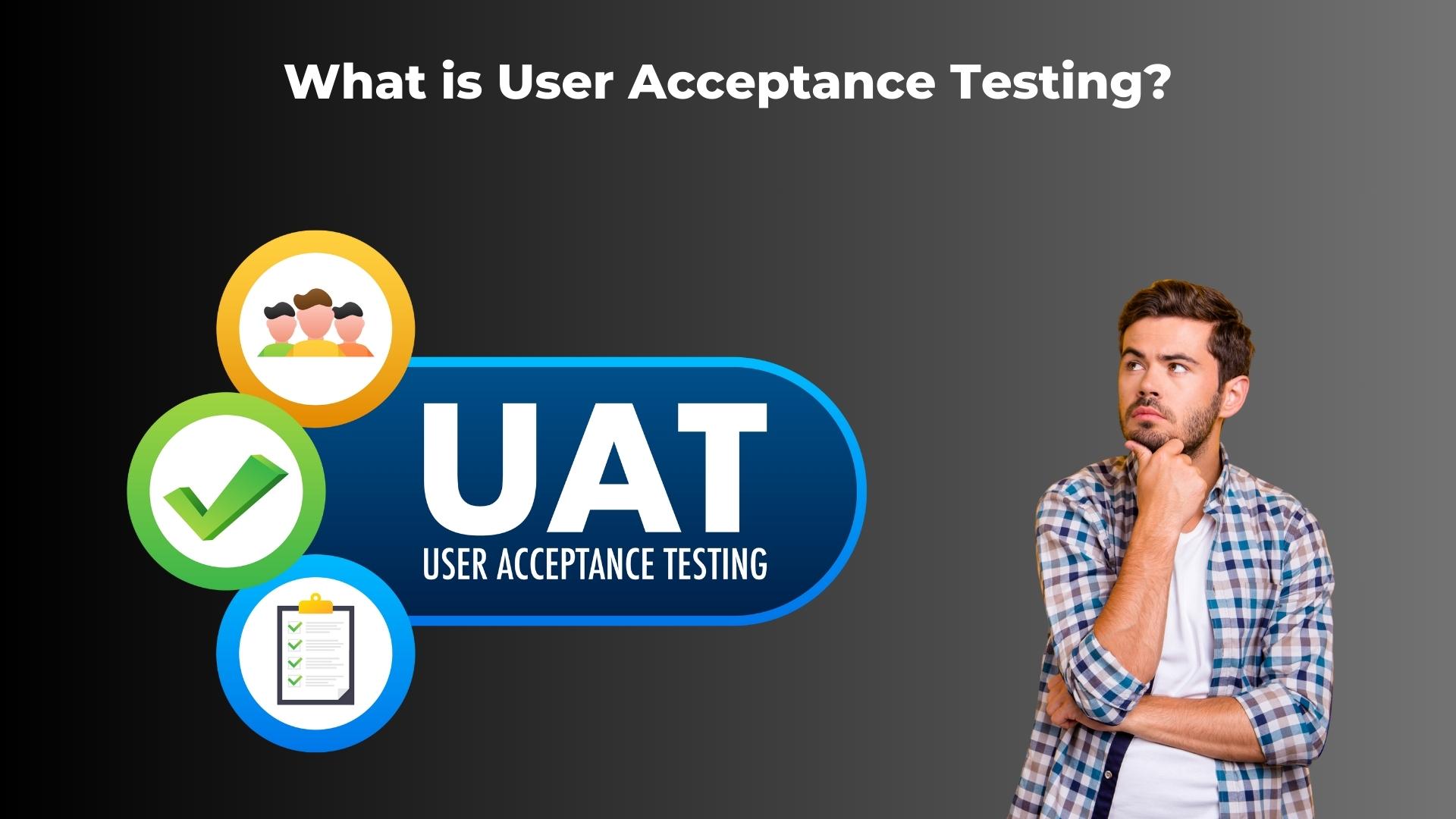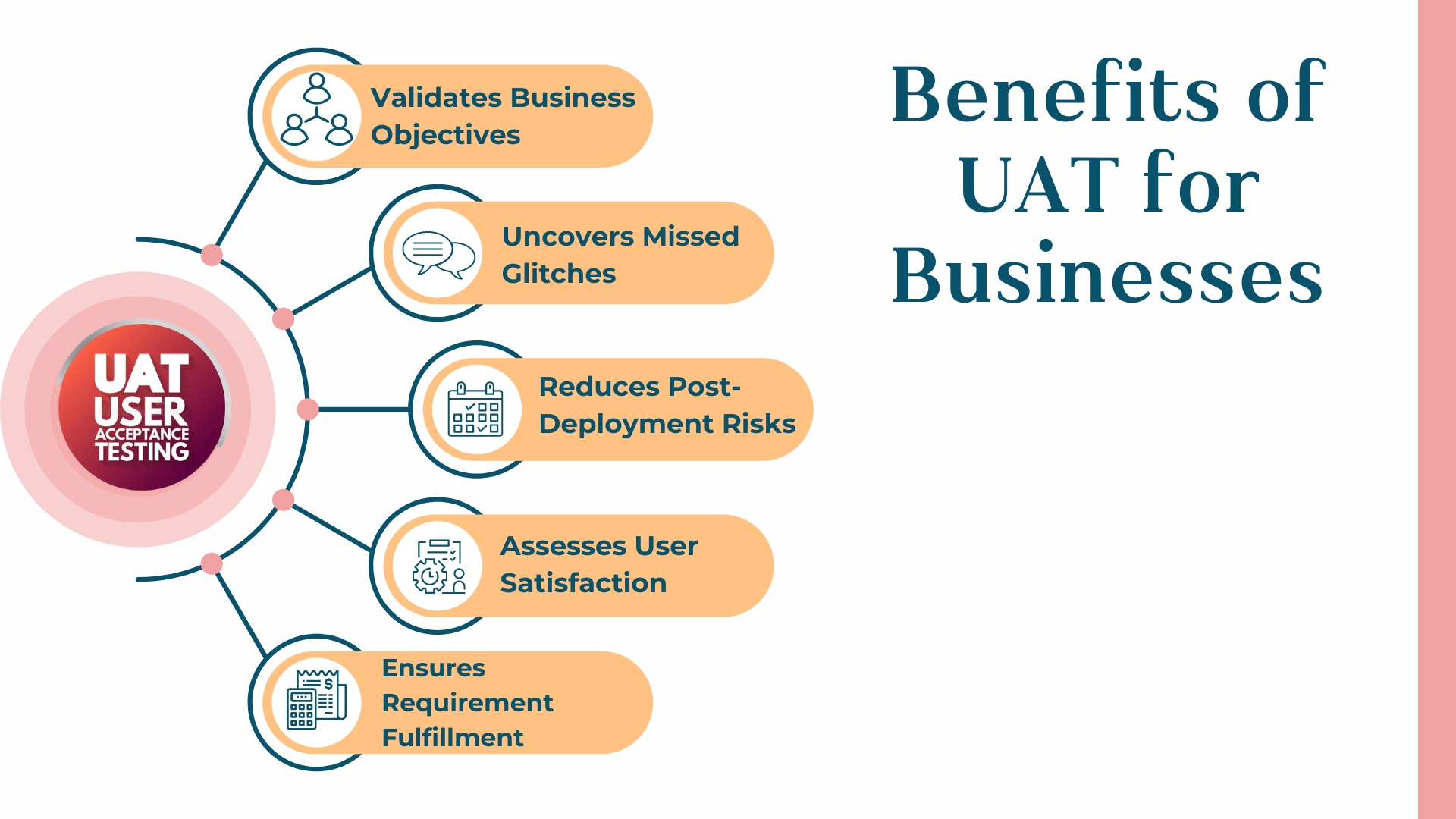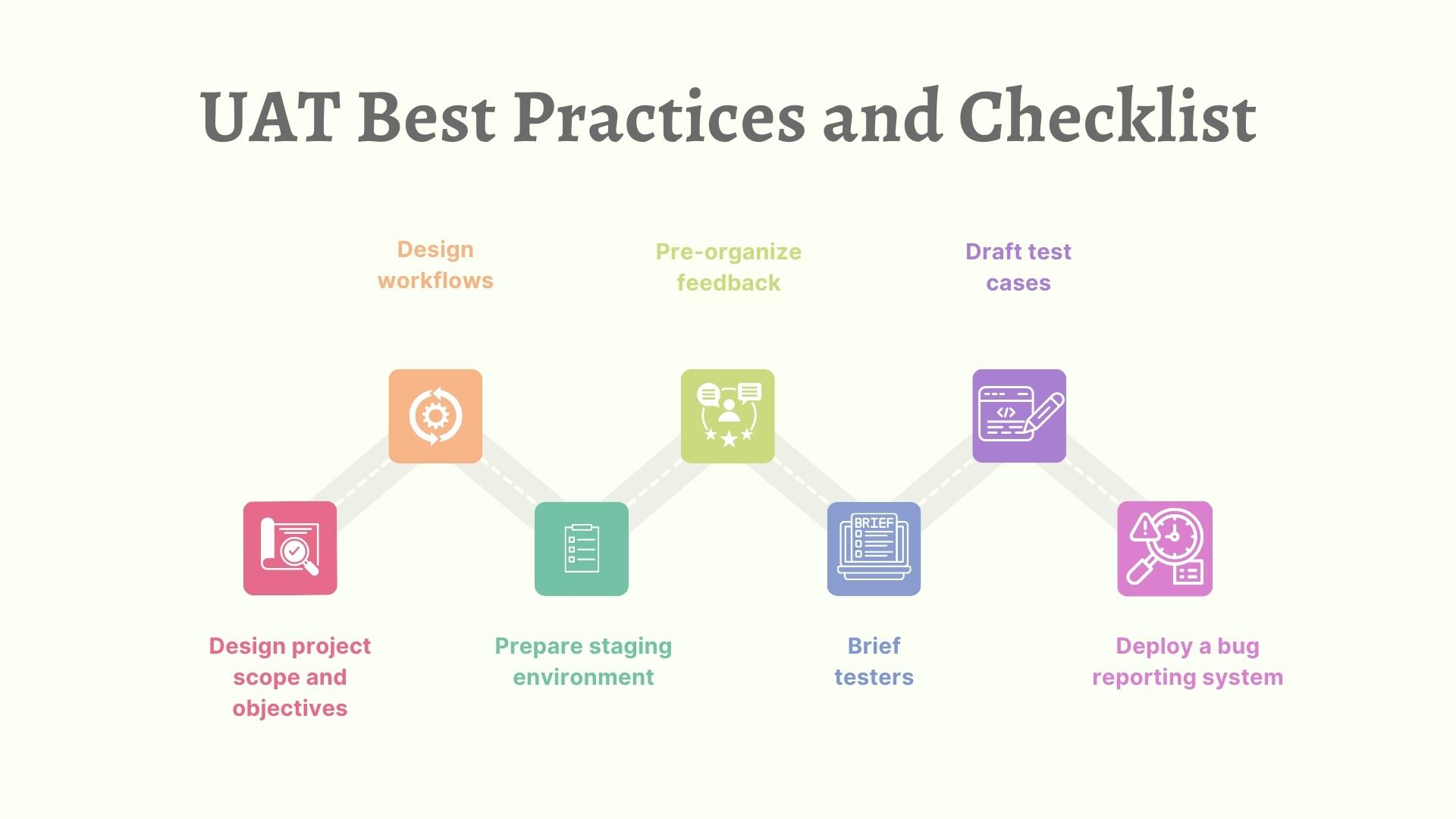What is User Acceptance Testing (UAT) & How It’s Performed
In a rapidly changing world dominated by technology, adapting and innovating quickly is more crucial than ever. Technology isn’t just a tool anymore; it’s the foundation of almost all business activities.
New technological solutions and platforms are appearing at an extraordinary pace. Companies find themselves in a race, not just against time but also against competitors, to introduce new products and services.
To win this race and ensure what they offer meets the demands of both business users and end customers, they can turn to User Acceptance Testing or UAT. This approach is not only efficient in time and cost but also effective in increasing customer satisfaction. This blog post will cover everything you need to know about UAT testing.
Table of Contents:
What is UAT Testing?

User Acceptance Testing, often known as end-user testing, user acceptability verification, or beta evaluation, involves checking software by its potential users to determine whether it’s good enough to go live.
These testers understand the business needs that the software is supposed to meet, allowing them to judge if the product is ready for deployment effectively.
When is it performed?
UAT is viewed as the final stage in the software testing cycle after completing functional, system, and regression testing. It’s the ultimate trial before the product is released or the client gives the green light.
Think of UAT as the finishing touch on the testing process; it only occurs after all other tests have been wrapped up. Acceptance testing includes alpha, beta, and UAT as its main components.
Who performs UAT?
UAT can be performed by:
- Real users of the current product,
- Users of an older version of the product,
- Stakeholders who took part in the product’s creation,
- Business analysts act as end-user experts.
This allows the development team to address most usability issues, glitches, and unforeseen challenges related to functionality, system architecture, business needs, etc.
What happens during a UAT session?

UAT sessions can differ, but usually, the software testers start by outlining the test procedures and the tools involved. They then generally show off the main capabilities of the software. Following this initial demo, the end-users test the application in real-life scenarios.
Once users have tested specific functions, the UAT group convenes to talk about what they’ve discovered, usually casually.
This is often when any glitches or issues come to light. Only if all functionalities have been examined and no problems have surfaced do testers move on to the final test stage, System Acceptance Testing (SAT).
The duration of a UAT session is project-dependent but is commonly one to two weeks long.
Types of UAT Testing

Various kinds of software assessments fall under the category of user acceptance testing. These tests consist of the following:
1. Beta testing
The software is shared with select groups of end-users who assess it for its design and offer improvement suggestions to the developers. Beta testing can be both closed, involving a specific group, or be open to the public, such as in the case of iOS and Android updates, and even Windows Insider builds.
2. Black box testing
In this type of testing, evaluators focus on assessing the software’s outputs based on specific inputs, without any knowledge of the software’s internal workings. It emphasizes the functionality and user experience rather than the intricate code details.
3. Operational acceptance testing
This method evaluates the software’s overall efficiency and operability in real-world conditions. It ensures the software not only functions but integrates seamlessly within its intended environment, checking factors like compatibility with other systems, reliability under varied conditions, and overall stability.
4. Contract acceptance testing
Here, the software is rigorously tested to ensure it meets the specific criteria and requirements outlined in the contractual agreement between the client and the development team. Every feature or capability promised in the contract must be demonstrably present and functioning as intended.
5. Regulation acceptance testing
More than just a standard evaluation, this testing method ensures the software adheres strictly to legal and regulatory standards. This is crucial for software used in sectors like finance or healthcare, where non-compliance could result in severe penalties.
UAT testing prerequisites
Before executing UAT, several conditions must be satisfied. These are:
- Business requirements are handed over to the testing squad.
- The system, integration, and unit tests finished with no high or medium-level defects or blockers.
- Regression testing is done so as not to impact the software.
- UAT setting set up and prepared.
How to execute UAT tests

The designated users of the software or system carry out UAT. This form of software testing often occurs at the client’s site, commonly called beta testing. Once the entry conditions for UAT have been met, here are the activities that testers need to complete:
Step 1: Analysis of business requirements
The first critical task in UAT is to pinpoint and formulate test scenarios. These scenarios are generated from these sources:
- Project outline
- Business use scenarios
- Process flow charts
- Business Requirement Files (BRF)
- System Requirement Guidelines (SRG)
Step 2: Creation of UAT plan
The UAT plan describes confirming that an application meets its business criteria. This plan logs UAT’s entry and exit conditions, outlines the test scenarios and methods, and sets the testing schedule.
Step 3: Identify test scenarios and test cases
Determine test scenarios based on the overarching business processes and develop examples with straightforward test steps. These test examples should cover the majority of UAT scenarios. Business use scenarios serve as the basis for creating these test examples.
Step 4: Preparation of test data
For UAT, it’s recommended to use real-world data. However, this data should be anonymized for privacy and safety concerns. Testers must be knowledgeable about the data flow in the database.
Step 5: Run and record the results
Carry out the test examples and report any issues. Re-examine the issues once they are resolved. Test management software can facilitate this stage.
Step 6: Confirming that business objectives are met
Either business analysts or UAT testers must send a confirmation email following UAT. Post-approval, the product is ready for live deployment. UAT deliverables include the test strategy, UAT scenarios and examples, test outcomes, and issue logs.
System testing vs. User Acceptance testing

The core distinction between system testing and user acceptance testing lies in their objectives. System testing aims to verify if the software aligns with the predefined requirements, whereas acceptance testing assesses if the software satisfies customer expectations.
Developers and testers perform system testing, whereas user acceptance testing involves stakeholders, clients, and external testers. Moreover, system testing encompasses integration and system tests, while user acceptance testing includes alpha and beta tests that is often left to the general population as a means of essentially free external testing for those who chose to opt into it.
What are the benefits of UAT for businesses?

- Confirms that the business objectives are achieved as outlined in the user narratives.
- UAT assists in uncovering glitches that might have been overlooked during integration testing.
- Diminishes the likelihood of encountering issues after the product has been deployed.
- Enables assessment of the application’s performance as envisioned by the product owner or the end-user.
- UAT guarantees that the completed application operates effectively and satisfies the business criteria detailed in the requirements documentation.
Major UAT testing challenges

UAT comes with various obstacles that companies must tackle for a successful test outcome. A major hurdle is the potential harm to the brand due to repeated tasks and additional testing.
If businesses keep using outdated resources like Excel or conventional test management systems, they may face issues coordinating with business users and lack a clear view of test progress. Moreover, linking with geographically spread-out business users can be expensive and time-consuming.
Other typical UAT difficulties involve non-expert business users, development user collaboration, minimizing downtime, and enhancing transparency and oversight in the testing procedure.
Obtaining high-quality test proof without affecting user efficiency, raising location expenses, or impeding the availability of business users.
UAT testing best practices and checklist

We know this is a lot to take, so we’re offering resources to aid your upcoming UAT session. This checklist serves as a concise summary of all the best practices for user acceptance testing.
- Design project scope and objectives: Clearly outline the new feature or software you’re launching. Revisit this document during UAT to confirm that issues have been adequately addressed.
- Design workflows: Workflows help get everyone on the same page. Distribute these to the testing team so they can precisely identify and provide real-time feedback on any problems.
- Prepare staging environment: Conduct tests in a secure space. A staging area is a perfect replica of your production environment and is ideal for alpha and beta testers.
- Pre-organize feedback: Classify feedback into two buckets: immediate action and further discussion.
- Brief testers: During alpha testing, thoroughly inform testers about the new feature. Clarify the business goal and what findings you anticipate from the test.
- Draft test cases: Prepare test cases for more extensive beta tests for all users to follow and report on. Include at least the steps for each test case and expected outcomes.
- Deploy a bug reporting system: Utilize a robust tool to support your development team.
Final thoughts
UAT is a critical step in software development, ensuring the end product aligns with business goals and user needs. The practice spans various forms, including Beta, Black Box, and Regulation acceptance testing, each serving specific purposes.
Executing UAT requires meticulous preparation, such as meeting certain prerequisites and carefully planning each test scenario. It’s essential to engage both technical and non-technical users for comprehensive insights.
Organizations can streamline the UAT process to achieve successful outcomes with a well-prepared checklist, incorporating project scope, workflows, and a dedicated bug reporting system.
FAQs
User Acceptance Testing is the stage where the created software is tested by its future users or those representing them. Often referred to as beta, end-user, or application testing, its primary focus is to validate the software in a real-world scenario.
1. UAT confirms that the software meets business goals and requirements – 2. It flags any lingering issues that survived previous rounds of testing. – 3. Reduces the likelihood of encountering bugs after the product launch. – 4. It earns the approval and confidence of the end-users for the software.
Before initiating UAT, ensure the code and test data are readily available. Ensure that prior testing phases, like regression testing, have been completed with no significant bugs found. Confirm that all identified defects have been addressed and re-tested. Comprehensive test planning should be done before commencing UAT.
Although both involve testing, UAT and QA (Quality Assurance) serve different purposes. QA focuses on the overall software development process, aiming for a bug-free end product, while UAT is designed to ensure the end user will get what they expect from the software.
In Agile methodology, UAT is performed for each product iteration. It is a crucial step where end users or clients evaluate if a feature meets its intended purpose. Unlike the Waterfall model, where it’s often the final phase, in Agile, UAT is a recurring activity.
 Reviewed by
Reviewed by 




